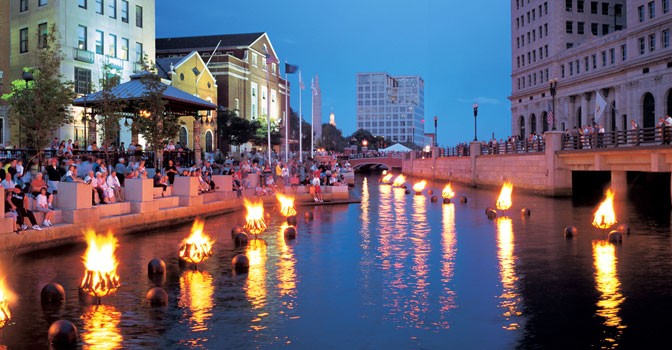Synaesthesia:
The experience of one sense as the result of the stimulation of another sense; for example, an experience of colour may result from hearing a sound.
From The Hutchinson Dictionary of Ideas, London
WaterFire® is a work of art that involves movement, participation and surprise. When visitors encounter WaterFire, they cannot absorb the sculpture from just their sense of sight or even from a single vantage point—they must walk through the installation and they must use all five of their senses. WaterFire is full of motion—throughout the night the firetenders stoke the fires, the boats glide past the flames, the rivers flow quietly beneath the braziers, the sparks whirl through the night air, and the flickering flames reflect off the dark surface of the water, animating the architectural fabric of the city.
The multi-sensory stimulation of WaterFire transforms our perceptions of the urban landscape. WaterFire opens all of our senses to our surroundings—it invites us to slow down and walk through the city in the European tradition of the paseo and the passeggiata. We savor the artwork’s surprises, view the city’s vistas and mingle with our fellow citizens. In the process, we recreate the public spaces of downtown Providence.
Ceremony:
Expression of shared feelings and attitudes through more or less formally ordered actions of an essentially symbolic nature performed on appropriate occasions. A ceremony involves stereotyped bodily movements, often in relation to objects possessing symbolic meaning… Ceremonies express, perpetuate, and transmit elements of the value and sentiment system and… they intensify the solidarity of the participants.
From the New Columbia Encyclopedia
The Classical Greek philosophers divided the world into four elements—earth, air, fire, and water. In the Chinese tradition there are five elements—earth, air, fire, and water, plus wood (or paper). In the Indian Buddhist tradition, the world is also composed of five elements—earth, air, fire, and water, plus space. Each of these five elements is paired with one of our five senses: fire is associated with sight; water with taste; earth with smell; and air with touch. The last element, empty space or the void, corresponds with sound and hearing. WaterFire incorporates all of these elements from these traditional systems into a new harmonious whole.
As WaterFire begins, the empty void is invoked through the striking of a large gong, which heralds the setting of the sun, the lighting of the fires and the beginning of the music for the evening. Music from all over the world and the gentle percussion of the crackling fires add a rich accompaniment to the more familiar sounds of urban life. An unexpected operatic aria blends with the wind, or a lingering minor chord from a nocturne intermingles with the sound of rippling water. These juxtapositions heighten our awareness and intensify our experience of our surroundings.
The elements water and fire are obviously the heart of the sculpture installation. The flames replace the glare of electrical light with the glow of ancient fire and celebrate a contemporary city’s heritage by illuminating its historic architecture with firelight. The reflective waters of the Providence, Woonasquatucket and Moshassuck Rivers unite the individual bonfires into a shimmering ribbon that winds through the park. Both water and fire are seen as living entities that possess a will and a spirit of their own. Water and fire symbolize life, fertility, creativity and inspiration in cultures around the world. At the same time, water and fire also represent loss, death, and destruction.
Water and fire are mutually destructive—water will extinguish a flame, just as fire will boil water away to nothing. The cold, dark sheen of the rivers temper the exuberance of the fires while the bright dancing flames enliven the quiet surface of the water. The delicate and unlikely balance of these two opposing forces creates the magic that lies at the heart of WaterFire.
Communitas:
The sense of sharing or intimacy that develops among persons who share a group experience.
From The Random House Dictionary of English Language
The other elements of earth, air and wood are represented as well. We see earth represented in the iron of the braziers and wood in the logs and kindling. We smell the fragrance of the pine and cedar in the air that envelops downtown in an ancient incense. The sparks from the wood fires reveal the swirling currents of the air—the same element also carries the music to our ears. As we promenade along the river, enjoying the scent and warmth in the air, we share not only a physical space, but also an atmospheric aura—both tangible and emotional.
We find different pleasures in our individual reveries at WaterFire. As we stroll among the celebrants along the riverbanks, we are brought out of ourselves and joined together in a shared aesthetic encounter reminiscent of an ancient communal ritual. The lighting of the WaterFire bonfires brings people and light and celebration to the dark streets and silent waterways of Providence. Log by log, fire by fire, night by night, and person by person, together we reclaim and rebuild our city. By gathering together at the heart of our downtown we are reaffirming our personal commitment to our community. All of us, both on the water and on the shore, are active participants in the creation of WaterFire. As we return home from the fires, we bring the magic of the evening and the spirit of the community back with us to our homes—along with a hint of the sweet scent of cedar.
—Barnaby Evans
